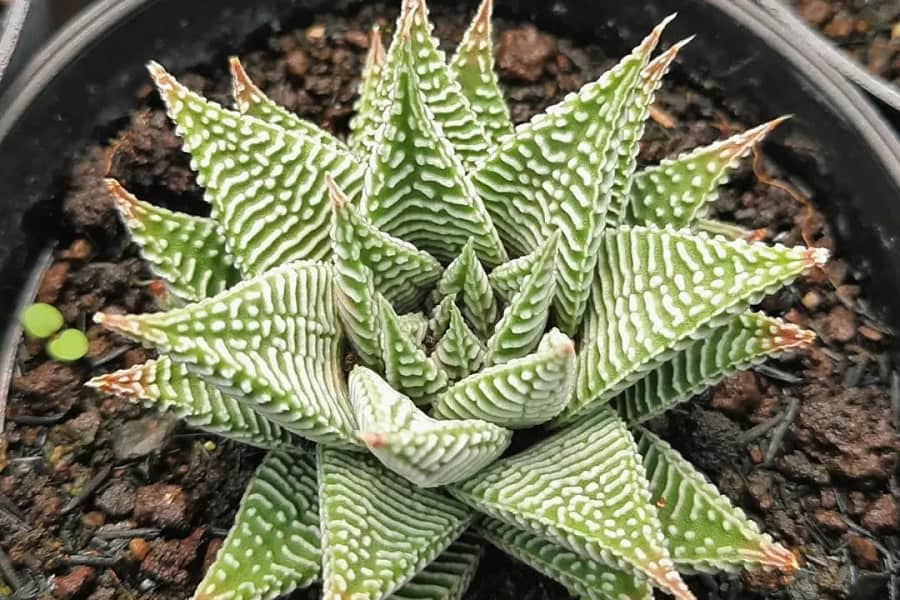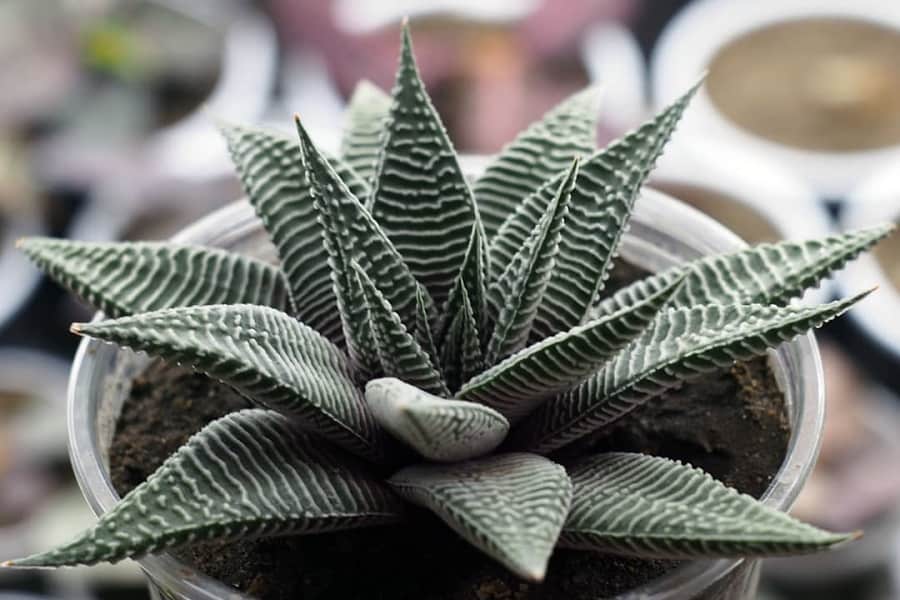Haworthia limifolia Striata: Characteristics and Care
Imagine a small, eye-catching succulent with dark green leaves radiating from its center. That’s the Haworthia limifolia Striata, a real beauty in the world of succulents. Its triangular leaves are adorned with white ridges, creating a stunning contrast that’s sure to catch your attention.
Despite its striking appearance, this little plant remains compact, growing no taller than 4 inches. But when it’s time to bloom, it puts on a show with white flowers adorned with green veins, emerging atop a tall stem that can reach up to 14 inches high.
Whether you’re a seasoned succulent enthusiast or just starting your collection, the Haworthia limifolia Striata is a captivating addition that’s sure to impress. And the best part? It’s surprisingly easy to care for, making it the perfect choice for both beginners and experienced green thumbs alike.

Related Post:
14 Types of Haworthia With Pictures
Contents
Haworthia limifolia Striata Care Guide
Caring for the Striped Haworthia is a breeze. Just be mindful of watering. Too much water can harm these little guys. Their fleshy roots are prone to rotting quickly if they get too soaked. Never overwater them. A light drink once a week is usually enough, even less in winter.
There’s some debate around fertilizing. Some succulent fans say no to fertilizers as it can change the plant’s growth. Others recommend using a weak cactus fertilizer regularly. The best approach is to experiment and see what works for your plant.
Other than that, there’s not much to worry about. These plants sail through winter with no fuss. The cooler it gets, the less water they need. Propagating is easy-peasy – the plants often take care of it themselves. Just separate the offsets and replant them. Overall, the Striped Haworthia is a versatile, low-maintenance gem.
Finding the Perfect Spot
The Striped Haworthia thrives best when you get its location right. Too much sun, whether indoors or out, is a no-go. These plants prefer a bit of shade.
- Bright, partially shaded spot
- Loves spending summer outdoors
- No direct sun – it can shrink the leaves
- Morning and evening sun is usually fine
- Slowly acclimatize when moving outdoors
- A rain-protected area is ideal
- Normal room temperature indoors
- Avoid heat buildup behind window panes
- East or west-facing windows are better
- Keep it cooler but bright in winter
- Supplement with grow lights if needed
The Right Soil Mix

For soil, go for a well-draining, mineral-based mix. This prevents waterlogging, which these plants hate. Pots with drainage holes are a must to let excess moisture escape. Steer clear of heavy, dense soils!
- Mix of sharp sand and loose, coarse potting mix (1:3 ratio)
- Light and well-draining
- No clay or peat
- Mineral substrates like pumice, lava rock, perlite, or coarse sand are ideal
Planting and Repotting Tips
Planting and repotting the Striped Haworthia is straightforward. Just make sure you’ve got the right soil mix. It’s a good idea to repot every other year or so.
- Use shallow containers
- Grouping multiple plants looks great
- Repot in early spring when growth starts
- Remove any dead leaves
- Only upsize the pot if rosettes cover the entire surface
- Annual or biennial repotting is best to remove old root matter and prevent rot
Watering and Fertilizing
Like all succulents, the Striped Haworthia is far more tolerant of drought than overwatering. It can survive extended dry spells, but constant moisture will quickly rot the roots. It’s a succulent, but it can’t handle severe drought either. Moderation is key!
- Water evenly during the main growing season (April to November)
- Allow the top inch or so of soil to dry between waterings
- Skip watering in July and August – just mist the plants for their resting period
- Significantly reduce water in winter
- Never water into the rosette center – risk of rot
- Feed monthly with a diluted cactus/succulent fertilizer
Pruning
The Striped Haworthia doesn’t need much pruning. Just snip off any dried leaves. You can take a leaf or offset for propagation if needed, but avoid excessive cutting.

Overwintering
These plants are winter champs. Again, be mindful of overwatering when temperatures drop, as they won’t need as much moisture. Standing water or constantly damp soil leads to rot, which can be fatal.
- Keep frost-free between 40-60°F
- Some varieties are surprisingly cold-hardy
- Around 60-65°F is also okay
- Avoid warm living rooms
- The warmer it is, the more light they need
- May need supplemental grow lights
Pests and Diseases
Pests like root mealybugs, scale insects, and other soil-dwelling bugs can be tricky to spot. They often hide in the rosettes or soil. Inspect your plants regularly. Common insecticides or neem oil can help control any pests.
Easy Propagation Methods
Propagating the Striped Haworthia is a breeze. You can go with leaf cuttings or seeds – both methods are straightforward.
Leaf Cuttings
- Remove a leaf from the mother plant
- Allow the cut end to dry for a few days
- Lay the leaf flat on a tray of potting mix
- Keep the soil evenly moist but not soaked
- Place in a bright, warm spot
- The leaf should sprout roots within weeks
- Then care for it like a mature plant
Seeds
- Use a fine, mineral seed-starting mix
- Can sow year-round at 60-70°F
- Overheating can halt germination
- Seed viability is limited to about 1 year
- Seedlings won’t be perfect clones
Whether propagating from leaves or seeds, the Striped Haworthia multiplies effortlessly, allowing you to spread the joy of these captivating succulents.
